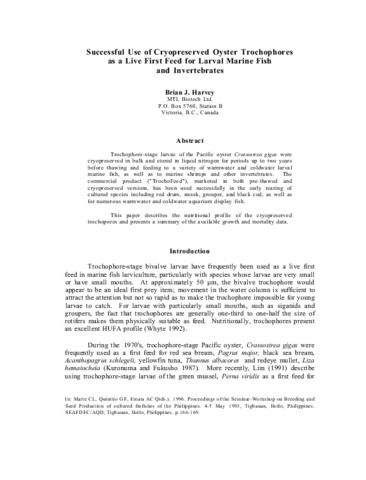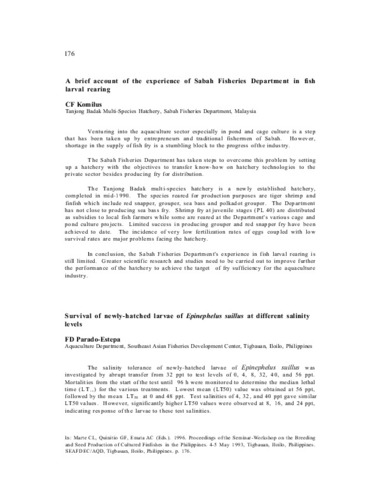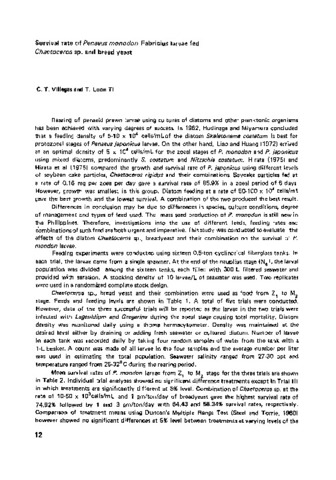Larviculture of marine species in Southeast Asia: current research and industry prospects
| dc.contributor.author | Marte, Clarissa L. | |
| dc.date.accessioned | 2014-04-01T06:04:26Z | |
| dc.date.available | 2014-04-01T06:04:26Z | |
| dc.date.issued | 2003 | |
| dc.identifier.citation | Marte, C. L. (2003). Larviculture of marine species in Southeast Asia: current research and industry prospects. Aquaculture, 227(1-4), 293-304. | en |
| dc.identifier.issn | 0044-8486 | |
| dc.identifier.uri | http://hdl.handle.net/10862/1971 | |
| dc.description.abstract | The increased requirement for food fish, the lucrative market for expensive seafood, and the need to conserve marine resources, have motivated the rapid pace of larviculture research in Southeast Asia. Various research and academic institutions in Southeast Asia such as the Southeast Asian Fisheries Development Center Aquaculture Department (SEAFDEC AQD) are carrying out research on commercially important marine species including 10 fish, 6 crustacean, and 7 mollusk species. Since fry availability is a major constraint in the development of culture systems, a major research thrust of SEAFDEC AQD is the development of commercially viable technologies for breeding and seed production of commercially important marine fish and crustaceans such as milkfish, groupers, snappers and mud crabs, in addition to the production of fry and juveniles of endangered and depleted species such as the sea horse and the tropical abalone for stock enhancement and sea ranching. Although hatchery production of milkfish and sea bass are now commercially viable enterprises, research is being pursued to improve fry quality through feed supplementation and to lower production cost by using alternative live or artificial feeds. Larviculture techniques are being developed for technically demanding species such as groupers and snappers. The recent success in larviculture of the mud crab Scylla serrata is expected to stimulate the growth of the mud crab industry in the region. Similarly, encouraging developments in the breeding and larviculture of the sea horse and mollusks such as the tropical abalone will provide the necessary support to carry out future stock enhancement and sea ranching programs for these species. | en |
| dc.language.iso | en | en |
| dc.publisher | Elsevier | en |
| dc.title | Larviculture of marine species in Southeast Asia: current research and industry prospects | en |
| dc.type | Article | en |
| dc.identifier.doi | 10.1016/S0044-8486(03)00510-6 | |
| dc.citation.volume | 227 | |
| dc.citation.issue | 1–4 | |
| dc.citation.spage | 293 | |
| dc.citation.epage | 304 | |
| dc.citation.journalTitle | Aquaculture | en |
| seafdecaqd.library.callnumber | VF SJ 0765 | |
| seafdecaqd.databank.controlnumber | 2003-31 | |
| dc.subject.asfa | crustacean culture | en |
| dc.subject.asfa | crustacean larvae | en |
| dc.subject.asfa | fish culture | en |
| dc.subject.asfa | fish larvae | en |
| dc.subject.asfa | mollusc culture | en |
| dc.subject.asfa | molluscan larvae | en |
| dc.subject.asfa | rearing techniques | en |
| dc.subject.asfa | seed production | en |
Files in this item
| Files | ขนาด | รูป | View |
|---|---|---|---|
|
There are no files associated with this item. |
|||
รายการนี้ปรากฏใน (s)
-
Journal Articles [1256]
These papers were contributed by Department staff to various national and international journals.



